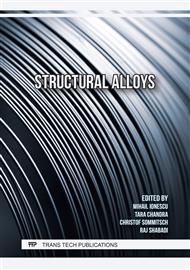p.3
p.11
p.19
p.25
p.31
p.37
p.47
p.53
Unusual Precipitation at Grain Boundaries in Non-Equiatomic CoCrFeMnNi High Entropy Alloys
Abstract:
In Cr-rich CoCrFeMnNi alloys, the precipitation of the σ phase at grain boundaries during recrystallization is so fast that ultrafine-grained structure is formed due to the pinning effect of the precipitates. The average grain size of the fcc parent phase is found to be consistent with modified Zener-Smith model. If conventional alloys come to equilibrium, volume fraction of precipitates should approach a saturation value. However, it is interesting to note that the volume fraction of the σ phase in Cr-rich CoCrFeMnNi alloys is inversely proportional to the average grain size of the fcc parent phase. For instance, in Co20Cr25Fe20Ni15Mn20 alloys, the volume fraction changes from 6.5% to 1.2% with increasing average gran size from 14 μm to 210 μm even after annealing at 1273 K for 100 h. It is well known that heterogeneous nucleation of precipitates at grain boundary is energetically favorable and fast diffusion through grain boundary can assist the precipitation. However, they cannot account for the grain size dependence of the volume fraction after reaching equilibrium. Based on stereology, the reciprocal of grain size is proportional to grain boundary area. Thus, chemical fluctuation at grain boundaries (e.g. segregation) is considered to be related to the unusual precipitation at the grain boundaries.
Info:
Periodical:
Pages:
25-30
Citation:
Online since:
December 2023
Authors:
Keywords:
Price:
Сopyright:
© 2023 Trans Tech Publications Ltd. All Rights Reserved
Share:
Citation:



